Siding replacement is a valuable investment for homeowners, offering improved insulation, enhanced aesthetics, and lower maintenance requirements. By upgrading to modern siding materials, you can boost your home’s energy efficiency, create a more appealing exterior, and reduce ongoing upkeep costs.

What are the benefits of siding replacement in Toronto?
Siding replacement in Toronto offers significant advantages, including improved insulation, enhanced aesthetics, and lower maintenance needs. These benefits can lead to increased energy efficiency, a more attractive home exterior, and reduced upkeep costs.
Improved insulation performance
Replacing siding can greatly enhance a home’s insulation performance, which is crucial in Toronto’s cold winters. New materials, such as insulated vinyl or fiber cement, provide better thermal resistance, helping to keep indoor temperatures stable and reducing heating costs.
Homeowners should consider options with high R-values, as these can significantly decrease energy consumption. Proper installation is also key; gaps or poor sealing can negate insulation benefits, so hiring experienced professionals is advisable.
Enhanced curb appeal
New siding can dramatically boost a home’s curb appeal, making it more attractive to visitors and potential buyers. In Toronto, where aesthetic standards can be high, choosing the right color and texture can set a home apart in the neighborhood.
Consider materials that complement the architectural style of your home. Options like wood, vinyl, or fiber cement can be customized in various colors and finishes, allowing for a personalized look that enhances overall property value.
Lower maintenance requirements
Modern siding materials often require less maintenance than older options. For instance, vinyl siding is resistant to fading, peeling, and rotting, making it a low-maintenance choice for Toronto homeowners.
Regular cleaning with mild soap and water is typically all that’s needed to keep new siding looking fresh. Additionally, many materials come with warranties that cover fading and damage, providing peace of mind and reducing long-term repair costs.
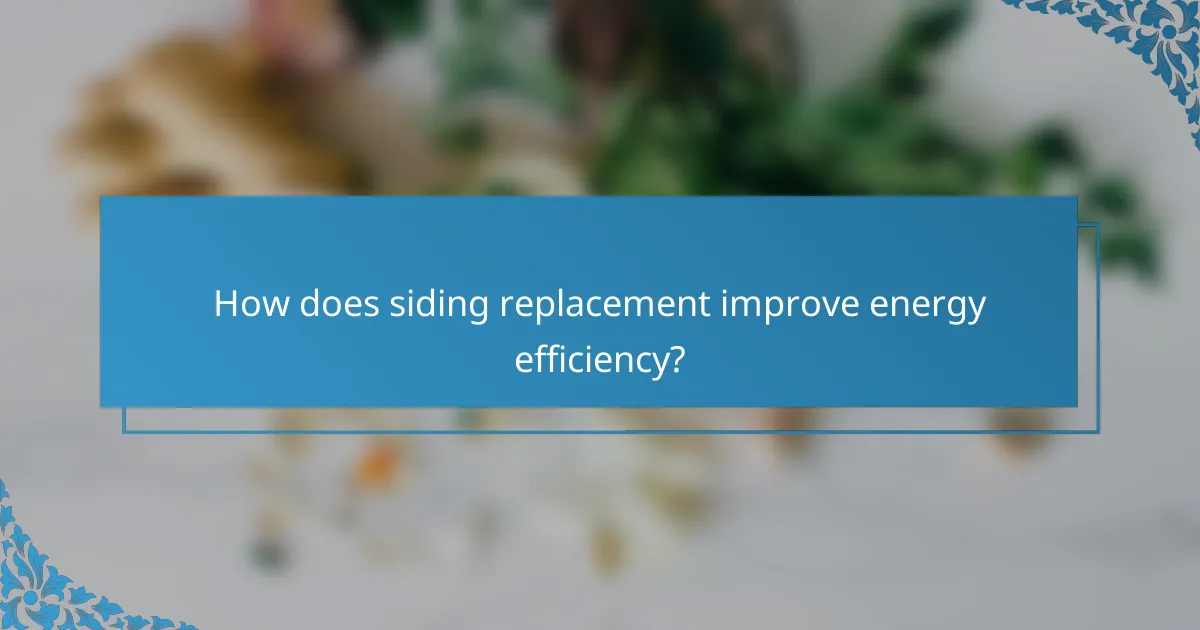
How does siding replacement improve energy efficiency?
Siding replacement enhances energy efficiency by providing better insulation, reducing heat loss, and minimizing energy costs. New siding materials can significantly improve a home’s thermal performance, leading to a more comfortable living environment and lower utility bills.
Insulating materials reduce heat loss
Insulating materials in siding help to create a barrier against temperature fluctuations, effectively reducing heat loss during colder months. Options like insulated vinyl or fiber cement siding can add an extra layer of thermal resistance, which is crucial for maintaining indoor comfort.
When selecting siding, consider materials with high R-values, which measure thermal resistance. Higher R-values indicate better insulation, meaning homes can retain heat more effectively, potentially lowering heating costs by a noticeable percentage.
Energy-efficient siding options
Energy-efficient siding options include insulated vinyl, fiber cement, and wood composites, each offering unique benefits. Insulated vinyl siding, for example, combines the aesthetic appeal of traditional vinyl with added insulation, making it a popular choice for homeowners looking to enhance energy efficiency.
When choosing siding, look for products that meet or exceed local energy efficiency standards. Many manufacturers provide ratings and certifications, such as ENERGY STAR, which can help guide your decision. Investing in energy-efficient siding can lead to long-term savings on energy bills and increase the overall value of your home.
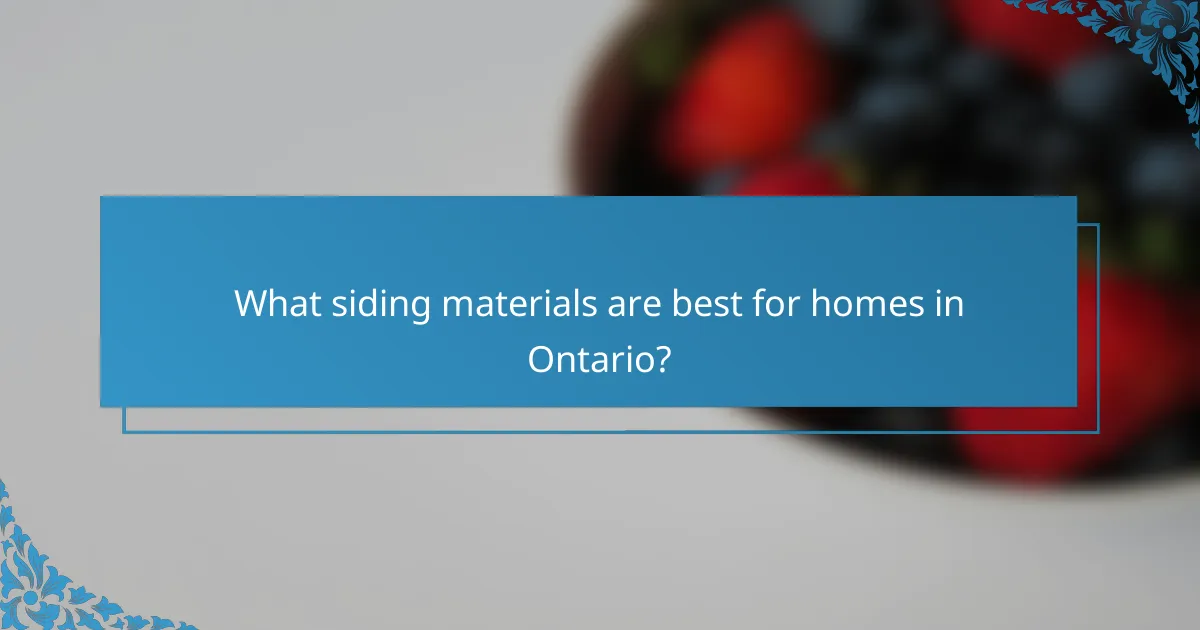
What siding materials are best for homes in Ontario?
In Ontario, the best siding materials for homes include vinyl, wood, and fiber cement. Each option offers unique benefits in terms of durability, aesthetics, and maintenance, making them suitable for the region’s climate and homeowner preferences.
Vinyl siding durability
Vinyl siding is known for its impressive durability, often lasting over 20 years with minimal maintenance. It is resistant to moisture, insects, and fading, making it an excellent choice for Ontario’s varied weather conditions.
When selecting vinyl siding, consider thickness and quality, as these factors significantly impact longevity. Look for products with a warranty of at least 30 years to ensure you are investing in a durable option.
Wood siding aesthetics
Wood siding provides a classic and natural appearance that many homeowners in Ontario appreciate. It can be stained or painted in various colors, allowing for personalized aesthetics that enhance curb appeal.
However, wood requires regular maintenance, including painting or staining every few years to prevent rot and insect damage. If you choose wood siding, consider using treated wood or species like cedar that are more resistant to the elements.
Fiber cement siding benefits
Fiber cement siding combines the best features of wood and vinyl, offering durability and aesthetic appeal. It is resistant to fire, insects, and rot, making it a strong contender for homes in Ontario.
This material can mimic the look of wood or stucco and typically requires less maintenance than wood. Fiber cement siding can last over 30 years, making it a cost-effective long-term investment for homeowners.

What is the siding replacement process?
The siding replacement process involves several key steps designed to enhance your home’s insulation, aesthetics, and reduce maintenance needs. It typically includes an initial assessment, material selection, and the actual installation of the new siding.
Initial assessment and consultation
The first step in the siding replacement process is a thorough assessment of your current siding and the underlying structure. A professional will evaluate the condition of your existing materials, check for any damage, and discuss your specific needs and preferences.
During the consultation, you will also explore various siding options that align with your budget and desired aesthetics. This stage is crucial for setting realistic expectations regarding costs, timelines, and potential challenges.
Material selection and ordering
Choosing the right siding material is essential for achieving improved insulation and aesthetics. Common options include vinyl, wood, fiber cement, and metal, each with its own benefits and drawbacks.
Once you select a material, the next step is to place an order. Be sure to account for factors like delivery times and any local regulations that may affect installation. It’s advisable to order a little extra material to cover any unforeseen issues during installation.
Installation steps overview
The installation of new siding typically begins with removing the old material, followed by repairs to the underlying structure if necessary. This ensures a solid foundation for the new siding.
Next, the new siding is installed according to the manufacturer’s specifications, which may include applying a moisture barrier and insulation. Proper installation is critical to maximizing energy efficiency and longevity.
Finally, finishing touches such as trim work and caulking are applied to ensure a polished look and prevent moisture intrusion. Regular inspections after installation can help maintain the integrity of your new siding over time.
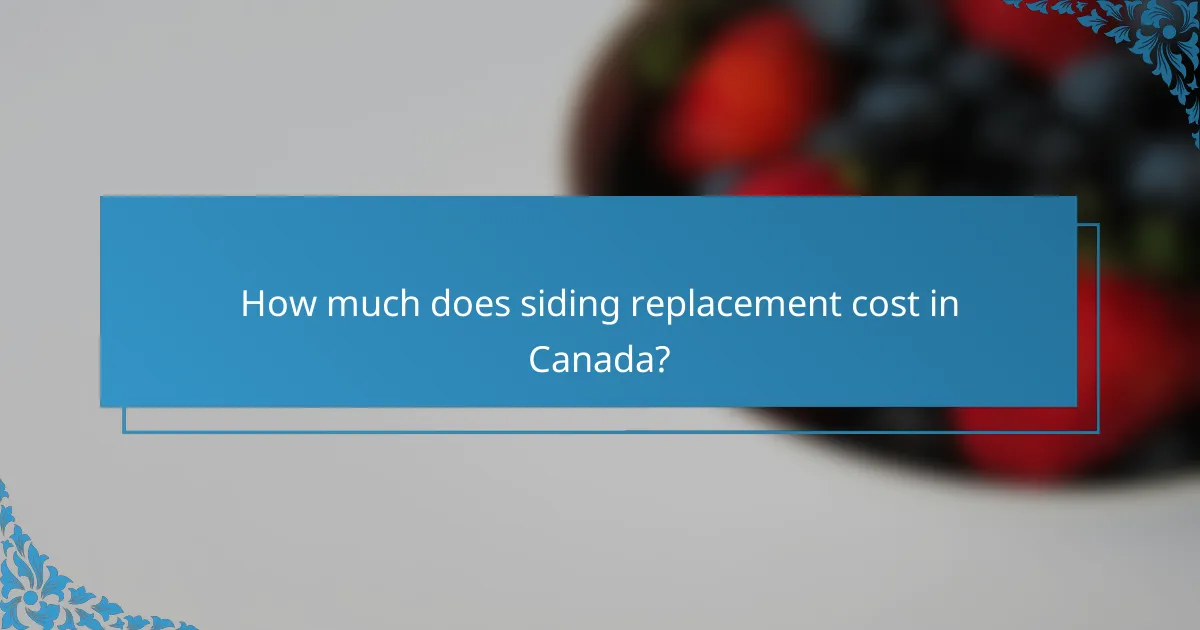
How much does siding replacement cost in Canada?
The cost of siding replacement in Canada typically ranges from CAD 5 to CAD 15 per square foot, depending on the materials and labor involved. Homeowners should consider both the upfront costs and the long-term benefits, such as improved insulation and lower maintenance needs.
Average cost per square foot
The average cost per square foot for siding replacement varies based on the type of siding chosen. Vinyl siding generally falls between CAD 5 to CAD 10 per square foot, while wood siding can range from CAD 8 to CAD 15 per square foot. Higher-end materials like fiber cement may cost CAD 10 to CAD 20 per square foot.
Factors affecting pricing
Other considerations include the condition of the existing siding and any necessary repairs to the underlying structure, which can add to the total cost. Seasonal demand can also affect pricing, with peak seasons potentially leading to higher labor costs.
Financing options available
Government programs may also provide financial assistance or incentives for energy-efficient upgrades, including siding replacement. It’s advisable to research local options and consult with financial institutions to find the best financing solution for your project.
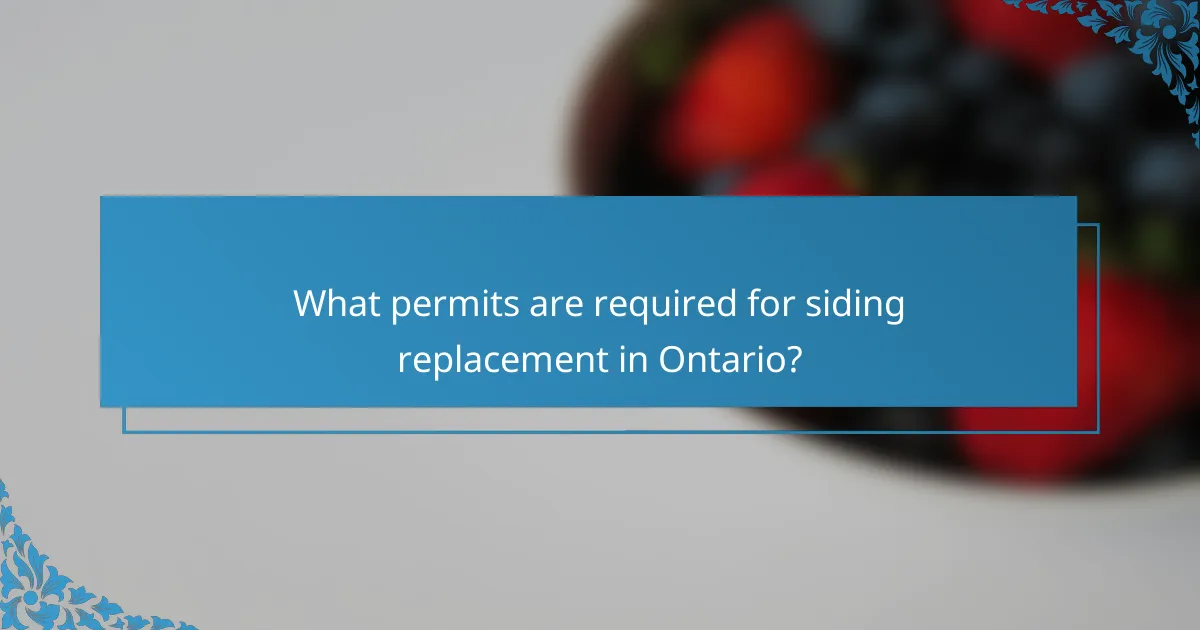
What permits are required for siding replacement in Ontario?
In Ontario, replacing siding typically requires a building permit, especially if the project involves structural changes or affects energy efficiency. Homeowners should check with their local municipality to ensure compliance with specific regulations and requirements.
Building permits overview
Building permits are essential for siding replacement projects that alter the exterior of a home. These permits ensure that the work meets safety and building standards. In Ontario, the application process usually involves submitting detailed plans and specifications of the proposed work.
Permit fees can vary based on the municipality and the scope of the project, often ranging from a few hundred to over a thousand Canadian dollars. It’s advisable to apply for the permit before starting any work to avoid potential fines or required removal of completed work.
Local zoning regulations
Local zoning regulations in Ontario dictate how properties can be modified, including siding replacement. These regulations may specify acceptable materials, colors, and design features to maintain neighborhood aesthetics. Homeowners should consult their local zoning by-laws to understand any restrictions that may apply.
In some cases, homeowners may need to provide evidence that their siding choice aligns with community standards or obtain additional approvals from neighborhood associations. Understanding these regulations can prevent delays and ensure a smoother replacement process.
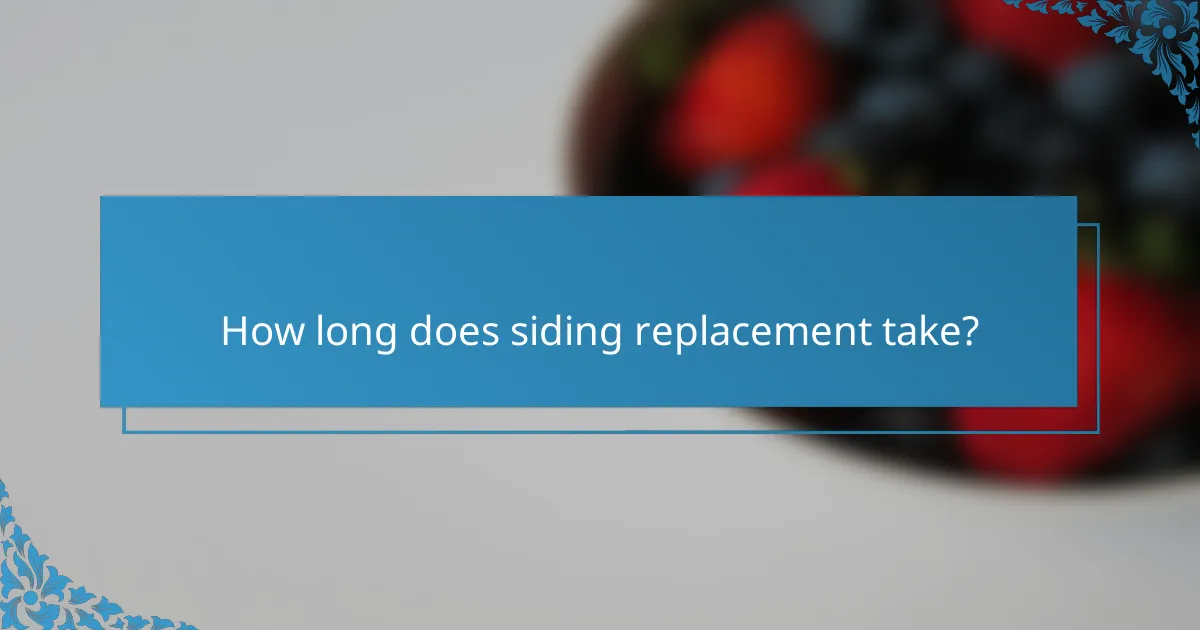
How long does siding replacement take?
Siding replacement typically takes anywhere from a few days to a couple of weeks, depending on the size of the home and the type of siding being installed. Factors such as weather conditions and the complexity of the project can also influence the timeline.
Improved insulation
Replacing siding can significantly enhance your home’s insulation, which helps maintain a comfortable indoor temperature and reduces energy costs. Newer siding materials often have better insulating properties compared to older options, which can lead to improved energy efficiency.
When selecting siding, consider materials like insulated vinyl or fiber cement, which provide excellent thermal resistance. Proper installation is crucial; ensure that the siding is fitted correctly to maximize insulation benefits.
Enhanced aesthetics
New siding can dramatically improve your home’s curb appeal, making it look more modern and well-maintained. A variety of colors, textures, and styles are available, allowing homeowners to customize the appearance to match their personal taste and neighborhood aesthetics.
Consider trends in your area when choosing siding. For instance, natural wood finishes may be popular in rural settings, while sleek, modern materials might suit urban environments better. Investing in high-quality siding can also increase your home’s resale value.
Lower maintenance
Modern siding materials often require less maintenance than traditional options, saving you time and money in the long run. For example, vinyl siding is resistant to fading, peeling, and cracking, while fiber cement is less prone to damage from pests and weather.
To maintain your siding, regular cleaning is usually sufficient. Avoid using harsh chemicals and opt for a gentle pressure wash or a soft brush. Be sure to check for any signs of damage periodically to address issues before they escalate.
